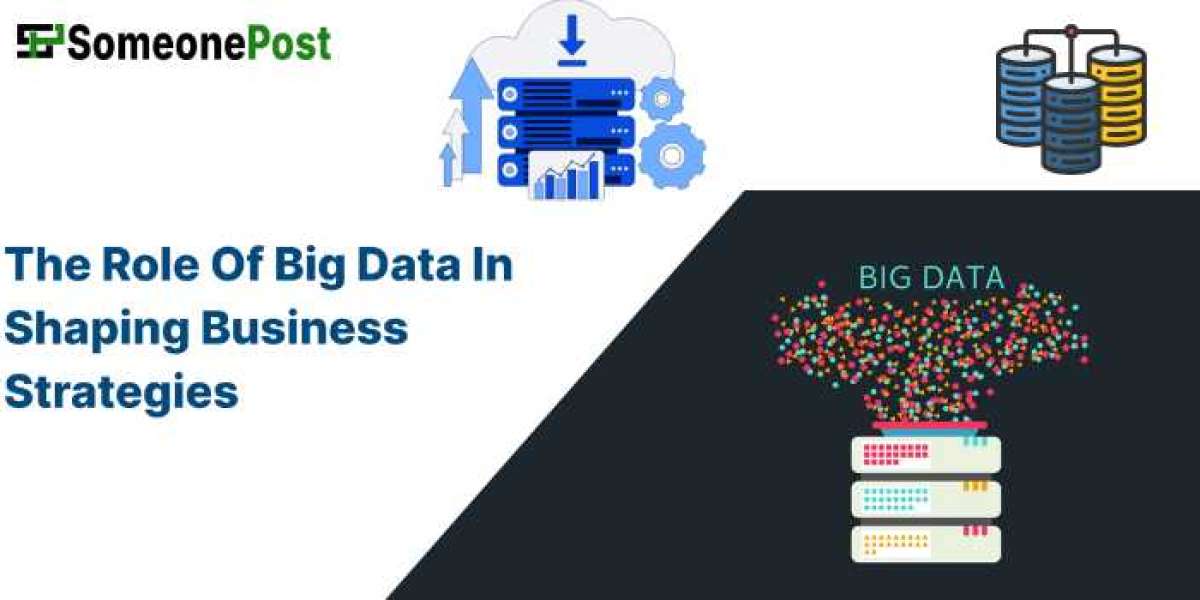In today’s digital-first world, businesses are no longer relying solely on intuition or traditional analytics to make decisions. The modern business landscape thrives on data — vast, complex, and rapidly expanding datasets that reveal deep insights into customer behavior, market trends, and operational efficiency. This explosion of information has given rise to one of the most transformative concepts of the 21st century — Big Data.
Big Data has become the backbone of innovation, competitive intelligence, and strategic decision-making across industries. From global corporations to emerging startups, every business seeks to leverage data to gain actionable insights and maintain a competitive edge. But what exactly is the role of Big Data in shaping business strategies, and how is it influencing the way organizations plan for the future?
This comprehensive article explores how Big Data is revolutionizing corporate strategy, its applications across sectors, and why it has become indispensable for growth and sustainability.
1. Understanding Big Data and Its Importance
Big Data refers to large volumes of structured and unstructured data generated by various digital sources such as social media, sensors, transactions, mobile devices, and IoT systems. The sheer volume, velocity, and variety of this data go beyond what traditional tools can manage effectively.
To harness the true potential of Big Data, companies use advanced technologies like Artificial Intelligence (AI), Machine Learning (ML), data mining, and predictive analytics to interpret and extract value from these massive datasets.
Why Big Data Matters
- Enhanced Decision-Making: Data-driven decisions are more accurate and reduce risks.
- Operational Efficiency: Insights from data streamline processes and eliminate inefficiencies.
- Customer Insights: Businesses can understand consumer behavior and preferences at a granular level.
- Innovation: Predictive models can identify new product opportunities and emerging trends.
Big Data doesn’t just help companies understand “what happened” — it reveals why it happened and what’s likely to happen next.
2. Evolution of Big Data in the Business World
The concept of Big Data isn’t entirely new. Businesses have always collected and analyzed information to make decisions. However, the scale and complexity of data today have grown exponentially.
In the past, companies relied on spreadsheets or basic databases. Now, they deal with petabytes of data generated every second. The evolution of cloud computing, mobile technology, and AI-powered analytics has made it possible to process and interpret this data efficiently.
Key Milestones in the Evolution of Big Data:
- 1990s: Rise of relational databases and basic analytics.
- 2000s: Emergence of internet data and digital footprints.
- 2010s: Big Data analytics tools like Hadoop and Spark revolutionized data handling.
- 2020s: Integration of AI and real-time analytics for instant insights and predictive modeling.
Today, data has become the “new oil” — a strategic asset that powers innovation, customer experience, and profitability.
3. The Role of Big Data in Shaping Business Strategies
In the middle of every successful business transformation lies the role of Big Data in shaping business strategies. Organizations are no longer making decisions based on assumptions or limited reports. Instead, they rely on comprehensive data models that provide a 360-degree view of their operations, markets, and customers.
Let’s explore how Big Data influences different aspects of strategic planning:
A. Customer-Centric Strategy Development
Customer preferences are constantly changing. Big Data allows companies to monitor customer behavior across multiple channels — social media, e-commerce, apps, and support systems.
By analyzing this data, businesses can:
- Create personalized marketing campaigns.
- Improve product recommendations.
- Predict customer churn and loyalty trends.
For example, streaming giants like Netflix and Spotify use Big Data analytics to understand viewing or listening patterns, which helps them recommend relevant content and retain users.
B. Predictive and Real-Time Decision-Making
Big Data enables predictive analytics, allowing companies to forecast trends and make proactive decisions. Retailers can anticipate demand surges, manufacturers can optimize supply chains, and financial institutions can predict market fluctuations.
In addition, real-time analytics provides instant insights, helping organizations make immediate strategic adjustments. This agility is critical in industries like finance, healthcare, and e-commerce where timing is everything.
C. Product Development and Innovation
Data analytics helps identify market gaps and consumer needs. By analyzing feedback, usage patterns, and online behavior, companies can innovate faster and design products that meet real-world demands.
For example, Amazon uses customer purchase data and reviews to identify product improvement opportunities and create new offerings. Similarly, automobile companies analyze sensor data from connected vehicles to enhance design and safety features.
D. Risk Management and Fraud Detection
Every business faces risks — from operational challenges to financial fraud. Big Data analytics helps mitigate these risks by detecting unusual patterns, anomalies, or inconsistencies in real time.
Banks and fintech firms use Big Data algorithms to detect fraudulent transactions instantly, saving billions annually. In supply chains, predictive models identify potential disruptions, enabling companies to act before issues escalate.
E. Operational Efficiency and Cost Reduction
Big Data optimizes internal operations by identifying bottlenecks, improving logistics, and automating repetitive tasks. Companies can analyze machine performance data to predict maintenance needs, reducing downtime and costs.
For instance, airlines use Big Data to predict aircraft maintenance schedules, minimizing delays and improving safety. In manufacturing, predictive maintenance powered by data analytics can save millions in operational costs.
F. Competitive Advantage
In the digital era, businesses that leverage data effectively gain a distinct competitive edge. Companies can benchmark their performance against competitors, identify market opportunities faster, and refine strategies based on factual insights rather than assumptions.
4. Big Data Across Industries: Real-World Applications
A. Retail and E-Commerce
Retailers use Big Data to personalize shopping experiences, forecast inventory, and optimize pricing. Data-driven marketing helps identify customer segments and boost conversions.
Example: Walmart uses predictive analytics to manage stock levels during peak seasons and local events.
B. Healthcare
In healthcare, Big Data plays a life-saving role. It helps in predicting disease outbreaks, improving diagnostics, and personalizing treatments.
Example: Hospitals analyze patient data to detect early symptoms and prevent chronic diseases through preventive care.
C. Finance and Banking
Banks rely on Big Data for credit risk analysis, fraud detection, and portfolio optimization. Real-time monitoring ensures secure and transparent transactions.
Example: Credit card companies detect suspicious activity within seconds using AI-based data models.
D. Manufacturing
Smart factories use IoT sensors and data analytics to monitor machinery, predict failures, and enhance production efficiency.
Example: Siemens leverages Big Data to predict equipment failures and optimize energy consumption.
E. Marketing and Advertising
Big Data transforms how brands engage with consumers. It provides detailed insights into audience behavior, enabling hyper-targeted ads and personalized content strategies.
Example: Google and Meta (Facebook) rely heavily on user data to refine ad targeting and increase ROI.
5. The Role of Artificial Intelligence in Big Data Analytics
AI and Big Data go hand in hand. Machine learning algorithms can process enormous amounts of data and identify hidden patterns that humans might overlook.
AI-powered analytics platforms can:
- Predict customer behavior more accurately.
- Automate data processing and visualization.
- Recommend strategic actions based on insights.
This integration accelerates decision-making and transforms data into a continuous source of strategic intelligence.
6. Challenges in Implementing Big Data Strategies
While the benefits of Big Data are immense, implementation comes with challenges:
A. Data Privacy and Security
Handling sensitive information requires robust cybersecurity and compliance with regulations like GDPR or India’s Digital Personal Data Protection Act.
B. Data Quality and Integration
Inconsistent, duplicate, or incomplete data can lead to inaccurate conclusions. Businesses must ensure clean, integrated data from reliable sources.
C. Skilled Workforce
Data scientists and analysts are in high demand, but there’s a talent gap. Organizations must invest in upskilling employees or hiring experts.
D. Infrastructure Costs
Storing and processing massive data volumes require advanced cloud infrastructure, which can be expensive for small and mid-sized enterprises.
E. Change Management
Adopting data-driven culture requires shifting mindsets from intuition-based decisions to analytical thinking.
7. How to Build a Big Data-Driven Business Strategy
Developing a successful Big Data strategy involves structured planning:
- Define Business Goals: Identify the problems data can solve — customer acquisition, cost reduction, or innovation.
- Collect Relevant Data: Gather internal and external data aligned with objectives.
- Use Advanced Tools: Employ AI-driven analytics platforms like Tableau, Power BI, or Apache Spark.
- Ensure Data Governance: Maintain data accuracy, privacy, and compliance.
- Invest in Talent: Hire skilled data analysts and engineers.
- Create a Data-Driven Culture: Encourage decision-making based on analytics rather than assumptions.
- Measure Performance: Regularly track KPIs to evaluate success and make iterative improvements.
8. Future Trends in Big Data and Business Strategy
The future of Big Data is more promising than ever. Here are upcoming trends shaping its evolution:
- Real-Time Analytics: Businesses will rely on instant insights to respond to market changes.
- Edge Computing: Data processing closer to the source (IoT devices) will reduce latency.
- AI Integration: Predictive and prescriptive analytics will become more sophisticated.
- Data Democratization: Self-service analytics will empower non-technical employees.
- Sustainability Analytics: Data will be used to optimize resource usage and support eco-friendly operations.
9. Case Study: How Starbucks Uses Big Data
Starbucks leverages Big Data to enhance customer experience and strategic planning. Using its loyalty app, it collects millions of data points on customer purchases, preferences, and locations.
Results:
- Personalized offers increase sales and engagement.
- Store placement decisions are based on data insights about demographics and traffic flow.
- Predictive analytics optimize inventory and staffing.
This data-driven approach has turned Starbucks into a model for customer-centric business strategy.
10. Conclusion: Data as the Driving Force of Modern Strategy
Big Data is not just a technological trend — it’s a strategic necessity for survival in the digital economy. By embracing analytics, businesses can transform uncertainty into opportunity and data into actionable intelligence.
The role of Big Data in shaping business strategies lies in its ability to uncover patterns, predict trends, and drive innovation. Whether it’s improving customer experiences, optimizing operations, or managing risks, data-driven strategies empower organizations to make smarter, faster, and more impactful decisions.
As we move further into the era of digital transformation, one truth remains constant: companies that harness the power of Big Data today will define the future of business tomorrow.



